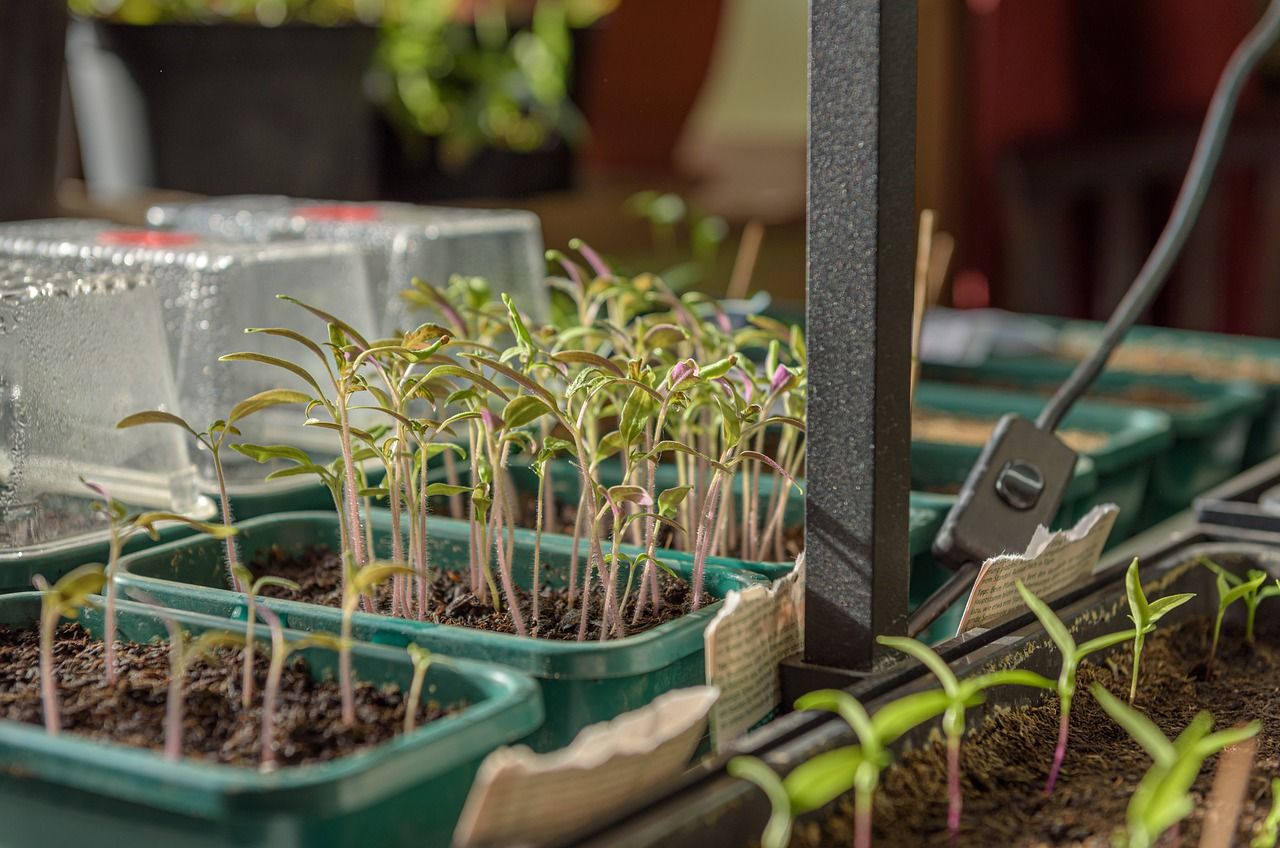As horticultural practices evolve, the importance of tailoring care to seasonal changes has become increasingly evident, particularly in mini greenhouse gardening. A mini greenhouse, by definition, is a controlled environment, giving gardeners the ability to manipulate factors such as temperature, humidity, and light.
However, each season has unique considerations that could mean the difference between a thriving plant sanctuary and a mediocre collection of pots. Whether sophisticated, fully equipped structures or small greenhouses and garden covers, these scaled-down gardening enclaves require knowledgeable, season-specific care to unlock their potential.
Spring: A Time of Awakening
Spring heralds the start of an active growing period and requires the gardener's attention in several areas. Here are some excellent ways to set the foundation for the year's growth.
Seed Starting
The controlled environment of a mini greenhouse makes it an ideal location for starting seeds. Gardeners can ensure high germination rates and protect young plants from lingering cold weather.
After seeds have germinated, providing them with enough light is essential, and they must be gradually acclimated to outside conditions before transplanting. This helps reduce the risk of transplant shock, enhancing plant survival and growth.
Temperature and Light Regulation
As spring temperatures rise, the greenhouse environment may risk overheating. Monitoring temperature and light levels is critical in maintaining a conducive growing environment.
Adequate ventilation and shading can help prevent overheating and light damage. Additionally, mitigating heat stress in plants can be achieved by watering at times of day when the heat is less intense.
Spring Cleaning
After winter's dormancy, spring provides an excellent opportunity for greenhouse cleaning and maintenance. Removing plant debris, cleaning surfaces, and checking for damage can preserve the greenhouse's structural integrity.
This cleaning process also minimizes potential pest and disease problems, preparing the greenhouse for the active growing season.
Soil Nutrient Replenishment
Over the winter rest period, the soil may become depleted of essential nutrients. These nutrients are vital for plant growth and should be replenished at the onset of spring. Amending the soil with compost or organic fertilizers can replace these nutrients and prepare the soil for the busy growing season ahead.
Summer: A Season of Abundance
Summer brings longer days, warmer temperatures, and the opportunity for various crops to flourish in the mini greenhouse. However, this season also brings unique challenges that need addressing.
Temperature Regulation
The summer months can bring high temperatures that risk overheating the mini greenhouse. To maintain optimal temperatures within the greenhouse, gardeners can use ventilation, shading, and evaporative cooling techniques. Maintaining appropriate temperatures prevents wilting and decreases pest and disease issues, ensuring plant health and productivity.
Watering
In summer, high light levels and temperatures can lead to plant dehydration. Plants may require extra watering to meet their hydration needs. However, avoiding overwatering is crucial, as it can lead to root rot and other problems. Striking a careful balance is essential to preserve soil moisture without tipping toward waterlogged conditions.
Plant Health Monitoring
The summer season requires particular attention to plant health. Regularly inspect plants for signs of pests and diseases, as promptly identifying and treating problems can prevent them from spreading and causing significant damage. This can preserve the productivity and aesthetic appeal of the greenhouse.
Crop Rotation
Crop rotation is a useful practice in the summer season. By changing the types of plants grown in the greenhouse, gardeners can prevent the build-up of pests and diseases specific to certain plants. Crop rotation also contributes to soil health by varying the nutrients taken up by different plant species.
Growing Heat-Loving Plants
The mini greenhouse's controlled environment allows growing plants to thrive in warmer conditions. These plants might not typically succeed in your outdoor garden due to your local climate.
Experimenting with such plants can diversify the greenhouse's produce and provide an exciting variation to the gardener's routine.
Autumn: A Time for Preparation
Autumn is a transitional season that ushers in cooler temperatures and a shift in crop varieties. It is also a time to reflect on the successes of the summer season and prepare for the coming winter months.
Harvest and Cleaning
Autumn is the season to harvest and remove summer crops. Clearing out spent plants can help reduce pest and disease problems, preparing the greenhouse for the new crops to come. After removing crops, thoroughly cleaning the greenhouse further reduces the risk of overwintering pests and diseases, ensuring a healthy start to the winter growing season.
Insulation
As temperatures drop in autumn, insulation becomes increasingly important. Installing bubble wrap or other insulating materials can help maintain a warmer greenhouse environment. This aids in protecting sensitive plants from frost damage, extending the growing season, and enhancing plant health.
Soil Testing and Amendment
Autumn is an ideal time for soil testing. Any nutrient deficiencies can be identified and corrected before the winter season. Also, by adding compost or organic matter, gardeners can improve soil structure and fertility for the next growing season, promoting healthy and vigorous plant growth.
Planting Cool-Season Crops
Autumn provides an opportunity for planting cool-season crops. Plants like lettuce, kale, and spinach can thrive in the greenhouse's cooler temperatures. This allows for a continuous supply of fresh produce throughout the winter months, maximizing the mini greenhouse's utility year-round.
Watering and Ventilation Adjustment
Watering and ventilation practices also need to be adjusted with changing autumn conditions. Overwatering can lead to damp conditions that encourage mould and mildew growth. As daylight decreases, plants require less water, and ventilation needs may also decrease, requiring modifications to greenhouse management routines.
Winter: A Season of Rest
The winter season signals a time of rest and preparation in the mini greenhouse. Maintenance activities become essential to keep the structure intact in the face of potentially harsh weather.
Winter Maintenance
Winter requires regular maintenance of the mini greenhouse. Snow must be removed from the greenhouse cover to prevent damage from the weight. Regular inspections for any damage or wear should be conducted, with prompt repairs made to prevent further deterioration, ensuring the longevity of the greenhouse structure.
Insulation and Heating
The colder winter temperatures require insulation and heating in the mini greenhouse. Even in a controlled environment, temperatures can drop significantly, threatening plant survival. Heaters, thermal mass, and bubble wrap insulation can contribute to maintaining a favourable climate for the plants, facilitating year-round cultivation.
Soil Rest
The winter season offers a chance to let the soil rest. Allowing soil to lie fallow can help break pest and disease cycles, improving soil health. This rest period can also improve soil structure and fertility, preparing it for the productive growing season.
Planning for the New Year
Winter provides a good opportunity for planning the upcoming year in the greenhouse. Ordering seeds, planning crop rotations, and strategizing improvements or changes to the greenhouse setup can be undertaken. This preparation can help ensure a successful growing season when spring arrives again, optimizing greenhouse productivity.
Careful Watering
Winter watering requires careful consideration. Plants need less water in colder temperatures, and overwatering can lead to soggy soil and root rot. Adjust watering schedules based on plant needs and greenhouse conditions to ensure the health and survival of the plants through the colder months.
Conclusion
Each season brings unique challenges and opportunities for mini greenhouse gardening. By adopting a seasonal approach, you can work harmoniously with nature's rhythms, optimize their growing conditions, and promote a healthier and more productive greenhouse environment.







